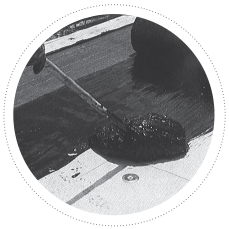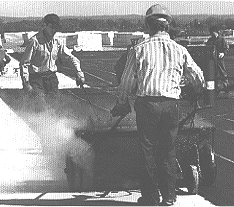 Hot asphalt or pitch is applied between the layers of felt and on the top surface in a thicker coat. The asphalt can be applied between the felt layers on the roof using either a hand mop, mini mopper, or a felt layer. The top coat, also called the flood coat or pour coat, is usually applied with dippers, pour cans, or mechanical spreaders.
Hot asphalt or pitch is applied between the layers of felt and on the top surface in a thicker coat. The asphalt can be applied between the felt layers on the roof using either a hand mop, mini mopper, or a felt layer. The top coat, also called the flood coat or pour coat, is usually applied with dippers, pour cans, or mechanical spreaders.
Sometimes temporary protection is required to the top of the felts before the application of the surfacing layer. This protection usually consists of a glaze coat which is a thin layer of bitumen applied to the top surface of the last ply. Glaze coats can be applied with mops or squeegees.
 The construction of a membrane with coal-tar pitch bitumen is essentially similar to the construction of a membrane with asphalt bitumen. The essential differences are that the felts are factory saturated with pitch rather than asphalt, the same volume of bitumen is used but it’s unit weight is higher due to the material’s higher density, and that pitch has a low softening point so it can be used only in very low slope (less than 1:25 or 4%) situations. Note that while pitch and asphalt are both bitumen, they are incompatible one with the other and cannot be used together in the construction of a roof membrane (i.e., pitch saturated felt cannot be used with asphalt bitumen, asphalt saturated felt cannot be used with pitch bitumen, and the different bitumen cannot be mixed).
The construction of a membrane with coal-tar pitch bitumen is essentially similar to the construction of a membrane with asphalt bitumen. The essential differences are that the felts are factory saturated with pitch rather than asphalt, the same volume of bitumen is used but it’s unit weight is higher due to the material’s higher density, and that pitch has a low softening point so it can be used only in very low slope (less than 1:25 or 4%) situations. Note that while pitch and asphalt are both bitumen, they are incompatible one with the other and cannot be used together in the construction of a roof membrane (i.e., pitch saturated felt cannot be used with asphalt bitumen, asphalt saturated felt cannot be used with pitch bitumen, and the different bitumen cannot be mixed).
Considering that the construction of pitch-based BUR membranes is no longer common in Canada, we will focus on the construction of asphaltic BUR membranes for the remainder of this section.
In order to construct an asphaltic BUR system, you must first determine the correct type of asphalt required for the slope of the roof. Once the asphalt type has been selected, it must be heated to ensure the proper application temperature (equiviscous temperature) at the point of application.
Asphalt Types
 The type of asphalt required is usually described in the job specifications based on the slope of the roof deck. There are four types of roofing asphalt generally used in Canada. Three types of asphalts are classified in accordance with CSA 123.4 Asphalt for Constructing Built-up Roofing Coverings and Waterproofing Systems and are designated as Type 1, 2 or 3 based on their measured softening points. These materials commonly are referred to as oxidized asphalts.
The type of asphalt required is usually described in the job specifications based on the slope of the roof deck. There are four types of roofing asphalt generally used in Canada. Three types of asphalts are classified in accordance with CSA 123.4 Asphalt for Constructing Built-up Roofing Coverings and Waterproofing Systems and are designated as Type 1, 2 or 3 based on their measured softening points. These materials commonly are referred to as oxidized asphalts.
The fourth type of material is asphalt that has had its properties modified by the addition of polymers with the primary modified being styrene-ethylene-butylene-styrene (SEBS) block copolymer. This material commonly is referred to as rubberized asphalt. The four types of roofing asphalt further are characterized as follows:
- Type 1 asphalt is required to have a minimum softening point of 60°C (140°F) and is intended for use on built-up roofs with slopes less than or equal to 1:16 or 6.2% slope (Consult local provincial requirements as minimum requirements may differ ex. Alberta Roofing Contractors Association (ARCA) specifies a 1:25 or 4% slope). Type 1 asphalt should not be used in roof systems where the membrane is constructed of inorganic reinforcements (i.e. fibreglass felts or polyester fabrics) because these types of reinforcements are very porous and the low melt asphalt will seep through them leaving the plies unbonded and potentially leaving bitumen voids through the depth of the membrane that can result in moisture entry.
- Type 2 asphalt is required to have a minimum softening point of 75°C (167°F). It is intended for use on built-up roofs with slopes less than or equal to 1:8 or 12.5% (ARCA specifies a 1:12 or 8.3% slope). Type 2 asphalt is a popular all-purpose roofing asphalt.
- Type 3 asphalt is required to have a minimum softening point of 90°C (194°F) and is intended for use on built-up roofs with slopes greater than 1:8 12.5% (ARCA specifies a 1:6 or 16.7% or less slope). Type 3 asphalt is also used to construct membrane flashings and to adhere layers of insulation to the deck or to each other.
- Styrene Ethylene Butylene Styrene (SEBS) modified asphalt is classified in accordance with ASTM D6152 Standard Specification for SEBS- Modified Mopping Asphalt Used in Roofing. ASTM D6152 compliant material is characterized by softening points in the range from 85°C to 135°C (185°F to 275°F).
A roofing application project may require the use of more than one of the above types of asphalt. If this is the case, the different asphalts should be melted in different kettles to ensure that the correct viscosity of the asphalts is maintained. Premature roof failure, caused by slippage of the membranes, usually results when hot-applied built-up roof systems are installed on slopes not intended for the application of the asphalt type used.
Heating Asphalt
 After you have determined the correct type of asphalt required for the given project, the asphalt must be properly heated in a roofing kettle. The kettle temperature will determine the asphalt temperature at the point of application. The proper application temperatures for a particular asphalt is listed on the package or may be obtained from the manufacturer.
After you have determined the correct type of asphalt required for the given project, the asphalt must be properly heated in a roofing kettle. The kettle temperature will determine the asphalt temperature at the point of application. The proper application temperatures for a particular asphalt is listed on the package or may be obtained from the manufacturer.
Asphalt is heated in a kettle to achieve the temperature for proper application or equiviscous temperature (EVT). The EVT is the point at which asphalt will be at the correct viscosity to obtain good flow, ensuring that the correct quantity will be applied and proper adhesion obtained. During application of the asphalt on the roof, this temperature must be maintained within 15°C/25°F of the EVT at the point of application. The temperature of the asphalt should be regularly checked with a thermometer.
In order to maintain the asphalts proper EVT at the point of application, the asphalt in the kettle will have to be heated to a slightly higher temperature. However, under no circumstances, should the asphalt in the kettle be heated to its flashpoint temperature as this may cause an explosion. Also, the asphalt should not be heated above its final blowing temperature as listed on the package by the manufacturer as this will result in damage to the asphalt.
As a general guide, never heat the asphalt 175°C (350°F) above the softening point. Overheating the asphalt will damage it or alter its type.
When the asphalt has been heated to the proper temperature, it can be applied on to the roof and roofing felts. However, the application of the asphalt depends on the type of felts; organic or inorganic, that are being used.
